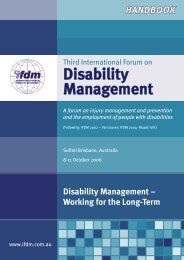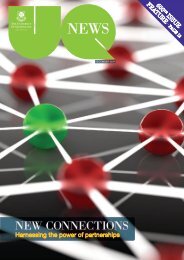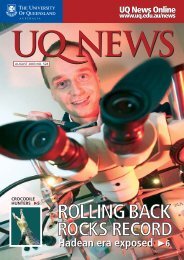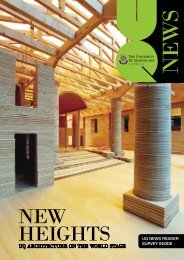Issue 562 (March 2007) - Office of Marketing and Communications
Issue 562 (March 2007) - Office of Marketing and Communications
Issue 562 (March 2007) - Office of Marketing and Communications
- No tags were found...
Create successful ePaper yourself
Turn your PDF publications into a flip-book with our unique Google optimized e-Paper software.
11U Q N E W S , M A R C H 2 0 0 7SMART LIGHTING SWITCHES ONLIGHTING EFFECTS COULD BE REVOLUTIONISED THANKS TO A NEW UQ ENGINEERING PROJECT.BY CAMERON PEGGIt’s not that <strong>of</strong>ten that an engineer findsinspiration for their research at the ballet. Butfor UQ graduate Aaron Tan, the theatre wasthe perfect place to start his search for smarterlighting design.Working with Dr Ralf Muhlberger from UQ’sSchool <strong>of</strong> Information Technology <strong>and</strong> ElectricalEngineering (ITEE), Mr Tan hopes to createthe world’s first interactive or affective lightingsystem, which can respond intuitively to themood <strong>of</strong> audience members <strong>and</strong> performers.At present, lighting design is both time <strong>and</strong>labour intensive, requiring each effect to beplotted manually during rehearsals <strong>and</strong> thenfollowed on cue during each performance.Mr Tan said two <strong>of</strong> his primary goals were todigitise the process – making it faster <strong>and</strong> moreefficient – <strong>and</strong> to produce lighting effects thatbetter reflected the emotions <strong>of</strong> those both on<strong>and</strong> <strong>of</strong>f the stage.“There’s really no intelligence behind currentmood lighting,” he said.“The technology in question enables morecontrol <strong>and</strong> accuracy in classifying emotion,providing a more robust <strong>and</strong> efficient approachto visual storytelling.“This will also reduce the mental workload<strong>of</strong> the operator <strong>and</strong> lighting designer.”Central to the project is the development<strong>of</strong> “emotional impact sliders”, which wouldallow designers to portray stock sensations(happiness, sadness, anger, shock, fear <strong>and</strong>disgust) more easily <strong>and</strong> effectively.Mr Tan’s undertaking is part <strong>of</strong> ITEE’sbroader research program into how emotionsare expressed <strong>and</strong> affected throughtechnologies such as video conferencing,computer games <strong>and</strong> email.“A lot <strong>of</strong> what we currently know aboutemotions is conjecture, <strong>and</strong> wishful thinking justisn’t science,” he said.“The measure <strong>of</strong> emotion is elusive in nature<strong>and</strong> I’m trying to improve that process.”As part <strong>of</strong> his research, Mr Tan attendedtechnical rehearsals for a recent Queensl<strong>and</strong>Ballet production, <strong>and</strong> consulted industryexperts including Steven Newman, director <strong>of</strong>photography on the blockbuster film SupermanReturns.He said a possible experiment involved placingsensors on a person’s skin to measure theiremotional reaction to different lighting effects.Once these values were quantified, Mr Tansaid lighting design could become a “smart”technology, which could sense the mood <strong>of</strong>users <strong>and</strong> adjust in real time.“The research has proved that intelligentlighting is possible today with emergingtechnologies,” he said.“As current user interfaces are inadequatefor the needs <strong>of</strong> emotion-based lighting, theresearch is also focused on new designinterfaces to define <strong>and</strong> represent emotions.“With more research, the mental control<strong>of</strong> lighting systems will be a reality in the nearfuture.”Researcher Aaron Tan (left) watches a lighting designer at work.
















